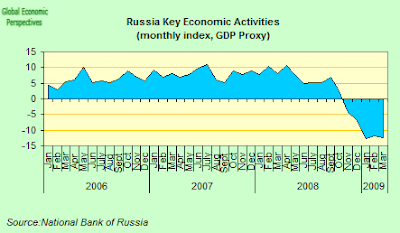"The Russian Government Forecasts A Possible 8% GDP Contraction For 2009 by Edward Hugh
Of course, with all these large negative numbers doing the rounds at the moment, we are all in danger of going rapidly dizzy, but some pieces of data still have the power to shock, like this morning’s announcement from Russia’s Economy Minister Elvira Nabiullina that the economy may shrink as much as 8 percent this year.
“The specific contraction numbers could be 4 percent or 6 percent or 8 percent,” Nabiullina said in an interview with Bloomberg Television in Moscow today. “We’re doing various calculations, pessimistic and optimistic. We believe much depends on how efficient we are.”
So the Russian Government is still running through the scenarios, and the ministry now promises to submit new growth forecasts by the end of the month, but it is worth bearing in mind that, as recently as last January, the most probable estimate stood at minus 2.2 percent. And the Economy Ministry aren’t the only ones with the excel sheets and calculators out - Alfa Bank, Russia’s largest private bank, Goldman Sachs, Citigroup and the International Monetary Fund have all revised their 2009 growth forecasts down recently, with Alfa this week cutting its outlook to minus 5.7 percent from an earlier anticipated drop of 3 percent. Nabiullina’s deputy, Andrei Klepach, recently described the International Monetary Fund’s estimate for a 6 percent annual drop as “realistic.”
Sharp Fall In Q1 GDP
Russia’s Q1 gross domestic product slumped back by an incredible 23 percent from the last three months of 2008, according to the latest (non seasonally corrected) preliminary data from the Federal Statistics Service.
“The big dip in industrial production jumps in your face,” said Tatiana Orlova, a Moscow-based economist with ING Groep NV, who plans to lower her forecast for a 2.7 percent contraction this year. “The government should be worried. It’s very easy to come up with headlines announcing bailout measures, but the situation shows that you have to adjust them. It’s hard to do these thingsfast.”
Yet despite the very bad first quarter numbers, and the pessimism which currently emanates from the Economy Ministry, a number of recent data points have been rather better (in the sense of less bad) than those were were seeing in January and February.
Both the PMIs and the GDP indicator were registering improvement, although the March Index of key economic activities - at minus 12.4% - was not that far off the February low of minus 12.6%, while April’s fall in industrial output was the worst to date.

Russian retail sales also fell again in March - at an annual 4 percent rate - registering their biggest decrease since September 1999.
Services PMI Shows Contraction Weakening
Russia’s VTB Bank services industries PMI came in at 44.4 last month, compared with 43.9 in March, suggesting some slight improvement in condition from one month to the next.
“The sector’s performance is still under pressure from the deteriorating business conditions on the back of weakening demand,” Svetlana Aslanova, an analyst at VTB Capital, said in the report.
While the index declined for the seventh consecutive month, the rebound from December’s record drop of 36.4 continued, with the rate of decline in new orders easing for the third consecutive month after registering a record contraction in January.
And inflationary pressures are weakening, with prices charged by companies declining for the first time since VTB started compiling the survey as providers competed by offering lower tariffs and discounts, the bank. In addition input prices advanced at the slowest pace on record.
The Contraction Softens In April
VTB Bank manufacturing PMI continued to signal that the sector remained in a strong downturn in April, although, as elsewhere, the rate of decline slowed again (for the fourth straight month) hitting the almost respectable level of 43.4 (in comparison with what is being seen elsewhere). This was the highest level in six months, although (in terms of historical comparisons) the latest results provide further evidence that the sector is experiencing a longer and more pronounced contraction than that seen during the financial crisis of 1998. At that time the PMI spent seven successive months in negative territory. In comparison the current run already extends to nine months - and we are still far from the end of the process - and in addition the rate of contraction has been much more pronounced.
According to VTB the largest component of the headline PMI – new orders – showed a weaker rate of decline in April. The rate of contraction in new business has now moderated continuously since hitting a survey record in December. However, new export business declined at a faster rate in April compared to March, suggesting that while the Russian administration’s stimulus plan may be having some impact, the devaluation of the ruble is yet to make any real impact, possibly due to the hefty rate of continuing internal price inflation and also due to the sorry state of international trade.
Worthy of note is the fact that a number of survey respondents linked lower output levels to payment problems at clients as credit conditions remain challenging.
Average input costs continued to increase in April, although at a weaker rate than that seen in the previous two months. Energy prices and exchange rate fluctuations were reported by firms to have increased costs, but this was partly offset by pressure on suppliers to discount rates as underlying demand remained weak. VTB reported that competitive pressure in the manufacturing sector was evident in April as firms cut output prices for the fifth time in six months. Manufacturers also continued to cut back their workforces in April, and employment in the manufacturing sector has now fallen continuously since May 2008, and the rate of job shedding remained marked despite easing for the third month running.
And The GDP Indicator Reflects The PMIs
Thus it is hardly surprising to find that the VTB Capital GDP Indicator showed the Russian economy contracting for the fifth month in a row in April, although again at a weaker rate. The indicator showed the economy contacting 4.7 percent year-on-year in April, after shrinking by a record low of 5.4 percent in March.
“The April PMI surveys suggest that stocks of finished goods were back to their long-run trend, and according to the GDP Indicator the pace of economic contraction already slowed in April”, VTB Capital senior economist Aleksandra Yevtifyeva said in the report. “The most encouraging trend in the recent survey is the moderation in unemployment growth in the manufacturing and services sectors……..This might lead to some stabilisation in consumption which has shown an increasingly rapid decline in the past two months…………Costs are increasing at a lower rate, while prices charged are falling. The latter is particularly important for the services sector, which recorded a drop in prices for the first time in the past seven years”.
Russia’s inflation rate fell more than expected in April, dropping to 13.2 percent after rising in March to 14 percent, and consumer-price growth slowed to 0.7 percent in the month, the Federal Statistics Service said yesterday, compared with 1.3 percent in March. Food price growth slowed to 0.6 percent in the month from 1.7 percent in March, according to the statement. In the year the rate eased to 14.5 percent from 23 percent in April 2008.
Allowing The Central Bank To Cut Rates
Russia’s central bank cut its main interest rates for the second time in less than a month last week. The bank cut its rates for the first time since 2007 on April 24. Bank Rossii lowered its refinancing rate to 12 percent from 12.5 percent and adjusted the repurchase rate charged on central bank loans to 11 percent from 11.5 percent.
The reduction is only the second since it made two increases in the refinancing rate and four in the repo during last autumn’s financial crisis. Borrowing costs were increased to arrest a 30 percent drop in the currency since August, spurred by falling oil prices after investors pulled money out of ruble- denominated assets.
Bank Rossii has also said it plans to raise the mandatory reserve requirements for banks by a half-point every month between May 1 and Aug. 1. The requirement currently stands at 0.5 percent for reserves held in rubles and 0.5 percent for bank’s foreign currency reserves. The move seems to signal that the central bank is gradually phasing out the aggressive reserve requirement easing steps it implemented last October in order to relieve banks of ammunition to bet on the ruble’s devaluation. Along with the rate cuts, this suggests that the central bank is confident that inflation will slow.
“Probably for the first time in our new history, we’ll be better than our official target” of 13 percent inflation, First Deputy Chairman Alexei Ulyukayev said in an interview yesterday. As inflation slows, possibly to 11 percent, “we can talk about the continuation of cutting the policy rate.”
Ulyukayev also suggested it was “probable” the bank would cut the key rates by a total of 1.5 percentage points this year.
Industrial Output Slides At Record Annual Pace In April
Russian industrial production fell at a record pace in April. Output dropped an annual 16.9 percent, the sixth consecutive decline and the biggest since the Federal Statistics Service moved to a new methodology in 2003, compared with a 13.7 percent annual drop in March. Production fell 8.1 percent from March, when it was up by 11.1 percent on February.
“The situation in manufacturing didn’t improve at all,” said Vladimir Tikhomirov, the chief economist at Moscow’s UralSib Financial Corp., before the report. “Companies were still under a big strain to try to attract capital and were diverting a lot of their investment money to repaying current debt. Investment programs had to be postponed.”
 Manufacturing output was down by an annual 25.1 percent in April, up from the 20.5 percent drop registered in March. Cement and brick output fell 34.7 percent and 39.9 percent respectively in April while production of trucks and vans fell 68.1 percent. Car production fell through the floor - dropping an annual 55.9 percent.
Manufacturing output was down by an annual 25.1 percent in April, up from the 20.5 percent drop registered in March. Cement and brick output fell 34.7 percent and 39.9 percent respectively in April while production of trucks and vans fell 68.1 percent. Car production fell through the floor - dropping an annual 55.9 percent.
Mixed Signals All Round
Despite some positive indications in April (or should I say, some less negative ones) the April industrial output number is a shocker, and especially the strong fall from March (although this may well not be working day corrected, and remember there was Easter in the middle). This continuing decline in manufacturing is sure to hit employment, and Ford began talks this week with the union at its plant near St. Petersburg to cut the workweek to four days to avoid overproduction, citing an anticipated 47 percent 2009 slump in what is now Europe’s second-biggest car market.
In a further sign the contraction may have picked up speed again, Russian producer prices fell by an annual 4.1 percent in April after falling 2.8 percent in March, according to the Federal Statistics Service in Moscow said today, although prices actually rose 2.4 percent from March. This was the fifth consecutive month of year on year price reduction.
Obviously a lot now depends on the evolution in oil prices, and Urals crude, Russia’s principal oil export blend, shot up 6.2 percent in April to $49.61 a barrel. However many analysts are question just how sustainable this surge in prices will prove to be given the very large current global capacity overhang.
Th ruble jumped to its strongest level in four months against the dollar today (Tuesday) as oil rose above $60 a barrel in New York trading. Some analysts, however, pointed to the fact that banks were also buying local currency to repay state loans and make tax payments. Russian banks need to pay back about 181 billion rubles ($5.7 billion) in unsecured loans plus interest by tomorrow, and 408 billion rubles in taxes must be paid by the end of May, according to Evgeniy Nadorshin, senior economist at Moscow’s Trust Investment Bank in a research note. Banks gained access to unsecured loans from the central bank in November as the government sought to bolster liquidity in the financial sector. Lenders have till tomorrow till tomorrow to repay the loans plus yield issued in auctions on April 13, Feb. 16 and on Nov. 17, according to Nadorshin.
Another possible reason for the firming of the ruble was pointed to by Deutsche Bank analysts in a recent research note: the juicy picking to be had from carry - juicy as long as the ruble doesn’t change course - given the high yield differential offered by Bank Rossii rates:
Currency deals that profit from the difference in interest rates globally are returning to favor on speculation the worst of the credit crisis may be over, spurring investors to buy eastern European assets, Deutsche Bank AG said. The Russian ruble, Hungarian forint and Turkish lira offer investors the best returns in the next two to three months thanks to the highest rates in the region, said Angus Halkett, a strategist at Deutsche Bank in London.
What this points to is the danger of “lock-in” here. The risk that the Russian central bank may not be able to reduce rates even as the economy contracts and inflation falls, since lowering beyond a certain threshold will almost certainly produce another bout of devaluation, and with it the danger of more conversion of rubles into dollars and general capital flight. This could be called “being stuck up a gum tree”.
Whatever the reasons - and high central bank interest rates will be one of them - the ruble has now clawed back some 13 percent of its 35 percent devaluation against the dollar in the six months preceding the end of January.
The Putin rescue programme does not seem to have worked as envisaged , and according to President Dmitry Medvedev (who may well have his own axes to grind) $9 billion slate of state guarantees “failed” to kick-start lending to strategic companies. The World Bank warned in their March report that a “silent tsunami” of bad debt still threatens to stall a recovery in the world’s largest energy-exporting economy, and as a growing number of companies default on loans, the government may need to provide as much as $50 billion for bank bailouts, more than twice the amount pledged to banks in this year’s budget, according to estimates by analysts from UniCredit’s Russian unit.
Finally, one of the reasons for the disparity between the more positive movement in the GDP indicator and the deterioration in general operating conditions may well be that the former does not include the key construction industry. Billionaire Mikhail Prokhorov, Russia’s richest man, said Russian property developers may suffer more as the country slides into the worst economic slowdown in a decade. “The crisis hasn’t hit developers in full yet,” Prokhorov told reporters in Yelets, Russia, on May 15. “The worst is yet to come.”














































No comments:
Post a Comment